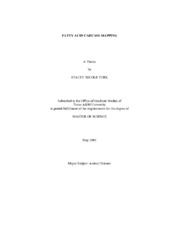Fatty Acid Carcass Mapping
Abstract
We hypothesized that subcutaneous (s.c.) adipose tissue would differ in
monounsaturated (MUFA) and saturated fatty acid (SFA) composition among different
depots throughout a beef carcass. To test this, 50 carcasses from a variety of breed types
and backgrounds were sampled. External fat samples were collected from eight different
carcass locations: round, sirloin, loin, rib, chuck, brisket, plate and flank. Samples were
used to provide information on slip points, fatty acid composition and MUFA:SFA
ratios. Lipids were extracted from s.c. adipose tissue by a modified
chloroform:methanol procedure, and fatty acid composition and slip points were
measured. The brisket was significantly lower in palmitic (16:0) and stearic (18:0) acid
than the other seven sampling sites (P = 0.001). The brisket demonstrated the highest
values of MUFA (P = 0.001) with the exception of possessing the lowest value of transvaccenic
(18:1t11) acid (P = 0.002). There were also significant differences in the
amounts of PUFA among the eight sampling sites. The lowest values were from the
brisket with a mean of 25.1. The flank had the highest slip point with a mean of 39.0
(P < or = 0.001). There was a high negative correlation shown between palmitoleic and
stearic acid (R2 = 0.827). The brisket displayed the highest values for MUFA:SFA ratios (P = 0.001), whereas the flank was the lowest. Due to the significant differences
amongst fat depots within bovine carcasses in their fatty acid composition we conclude
that substantial differences exist across fat depots.
Citation
Turk, Stacey N. (2008). Fatty Acid Carcass Mapping. Master's thesis, Texas A&M University. Available electronically from https : / /hdl .handle .net /1969 .1 /ETD -TAMU -2008 -05 -4.


